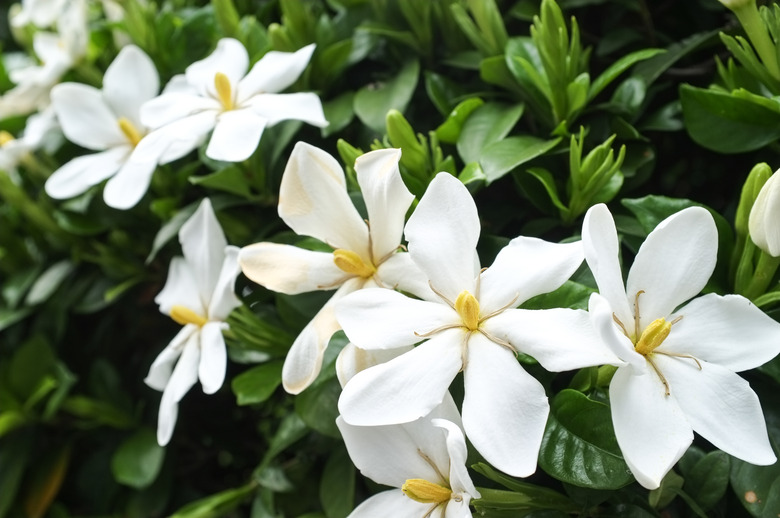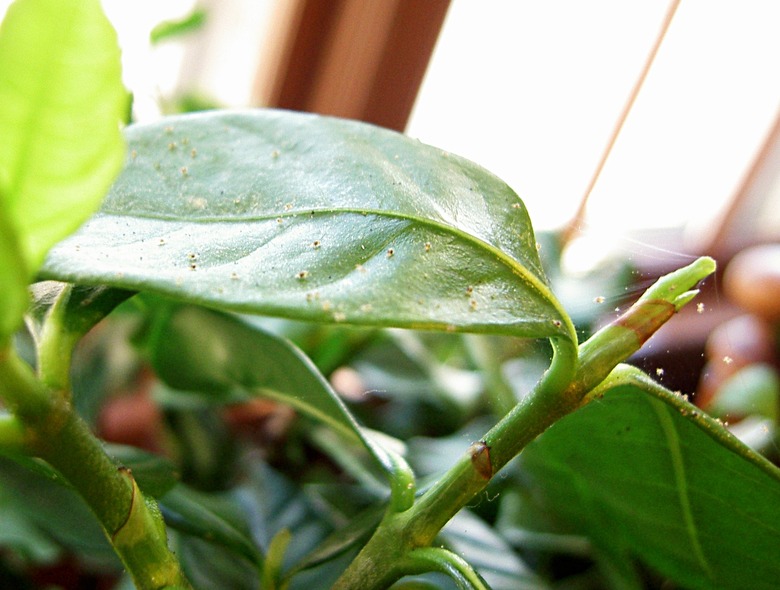Gardenia Plants: A Guide To Diseases And Pests
Gardenias (Gardenia spp.) are flowering shrubs cultivated for their fragrant white flowers and dazzling green foliage. There are some 200 gardenia species, the most popular of which is known as the cape jasmine (Gardenia jasminoides).
Various diseases and pests can detract from a gardenia shrub's beauty, however, and even shorten its life span. Here's a guide to identifying and treating these conditions.
Treatments for Diseases and Pests of Gardenia Plants
| Affliction | Symptoms | Treatment |
| Stem Cankers | A dark, sunken area on the stem that swells with time, forming a gall. | Prune damaged parts immediately. Maintain consistent watering and feeding regimen. |
| Root Rot | Yellowing of leaves and wilting; brown feeder roots. | Ensure proper soil drainage. Avoid planting again in the same spot. |
| Powdery Mildew | White, powdery fungal growth on the leaves; yellowing; leaf drop. | Maintain good air circulation; apply fungicide. |
| Leaf Spots | Reddish marks with yellowish tinge around the edges of the leaves, occasionally merging and forming irregular-shaped lesions. | Avoid watering gardenia plants overhead in order to keep the leaves dry; collect and discard infected leaves when they drop. |
| Sooty Mold | Black substance on the leaves secreted by insects. | Remove the insects either with streams of water or horticultural oil. |
Diseases of Gardenias
Here are two of the main diseases that can affect gardenias and what you can do about them.
Stem Cankers
According to the Texas A&M AgriLife Extension, one of the most common diseases in gardenias is the soil-level stem canker caused by the fungus Phomopsis gardeniae. This fungus usually enters a gardenia plant through a wound, which makes it preventable.
The canker may start off as a dark, sunken area on the stem that swells with time, forming a gall. Gardenia stem cankers can stunt the plant and eventually kill it.
So if you see any damaged parts of the plant, it's best to immediately prune those parts with shears that have been disinfected with a 70 percent alcohol solution before and after use. This prevents the fungus from having any wounds to enter the plant through.
It's also best to provide a consistent feeding and watering schedule to help avoid the plant from becoming stressed out or infected in the first place.
Root Rot
Gardenias can become infected with various species of fungi that cause their roots to decay, says the Clemson Cooperative Extension. One of the primary symptoms of this decay, known as root rot, is the yellowing of leaves and wilting, either throughout the entire plant or on one side.
A plant that is suffering from root rot will also have brown feeder roots, which are white in a healthy plant, that are also rotting or missing completely. Root rot can kill a gardenia plant.
Root rot is caused by excess water, so it is important to plant gardenias in soil that drains well. If you lose a gardenia plant to root rot, avoid planting again in the same spot, as the fungi that cause this condition linger in the soil.
Tip
Try to prune damaged parts of a gardenia plant immediately to help prevent cankers from forming.
Gardenia Leaf Problems
There are also a number of diseases that affect the leaves of gardenia plants as well.
Powdery Mildew
If you notice white stuff on gardenia leaves, it is likely powdery mildew, a fungal disease that thrives in humid conditions. Though powdery mildew rarely causes long-term damage to plants, it can still block sunlight from reaching the leaf tissue and cause yellowing and leaf drop.
Good air circulation is key to preventing powdery mildew, so be sure to give your gardenia shrubs adequate space.
Applying fungicides, such as myclobutanil, chlorothalonil or a mixture of horticultural oil and baking soda, at the first sign of powdery mildew can help to control the disease.
Leaf Spots
Gardenias are susceptible to unsightly leaf spots caused by both bacteria and fungi. Bacterial leaf spots manifest as reddish marks with yellowish tinge around the edges.
The spots sometimes grow large enough to the point of merging and forming irregular-shaped lesions. Rhizoctonia leaf spot, which is caused by a fungus, results in round spots.
In severe cases, leaf spots can cause a gardenia plant to lose all of its foliage.
Excess moisture encourages the development of leaf spots. Therefore, you should avoid watering gardenia plants overhead in order to keep the leaves dry. Collect and discard infected leaves when they drop.
Pests of Gardenias
There are also a handful of annoying pests that can harm your gardenia plants.
Sooty Mold: Secretions From Aphids, Scales, Mealybugs, Spider Mites and Whiteflies
A black substance on the surface of gardenia leaves is usually sooty mold, a type of a fungus that develops on honeydew. It is a sugary waste product secreted by insects, such as aphids, scales, mealybugs, spider mites and whiteflies.
To control sooty mold, you therefore need to control the insects dwelling on the plant. In the case of aphids and spider mites, a strong stream of water can remove many of the insects from the plant. Scale insects and whiteflies can be controlled with horticultural oil, says the Clemson Cooperative Extension.
Warning
Though insecticidal soaps can indeed kill certain annoying pests such as aphids, scales and whiteflies, they can also kill beneficial insects like ladybugs and lacewings. Additionally, gardenias are sensitive to insecticidal soaps, and spraying the plants with these soaps can end up doing more harm than good.
The Problems With Insecticidal Soaps
Insecticidal soaps also work on these insects; however, you should use care when applying these products to gardenias, which are considered sensitive to insecticidal soap sprays.
Watering your gardenia plants well the day before spraying them with insecticidal soap and only spraying when temperatures are below 90°F can help prevent injury to the plant.
It is important not to spray chemicals that can kill beneficial insects, like lacewings and ladybugs, which are predators that help to keep many gardenia pests at bay. Killing these predators can cause gardenia insect infestations to get worse.
References
- University of Florida IFAS Extension: Gardenias
- Clemson Cooperative Extension: Gardenia Diseases & Other Problems
- Texas A&M AgriLife Extension: Texas Plant Disease Handbook – Gardenia (Cape Jasmine)
- Clemson Cooperative Extension: Gardenia Insects & Related Pests
- Clemson Cooperative Extension: Insecticidal Soaps for Garden Pest Control

